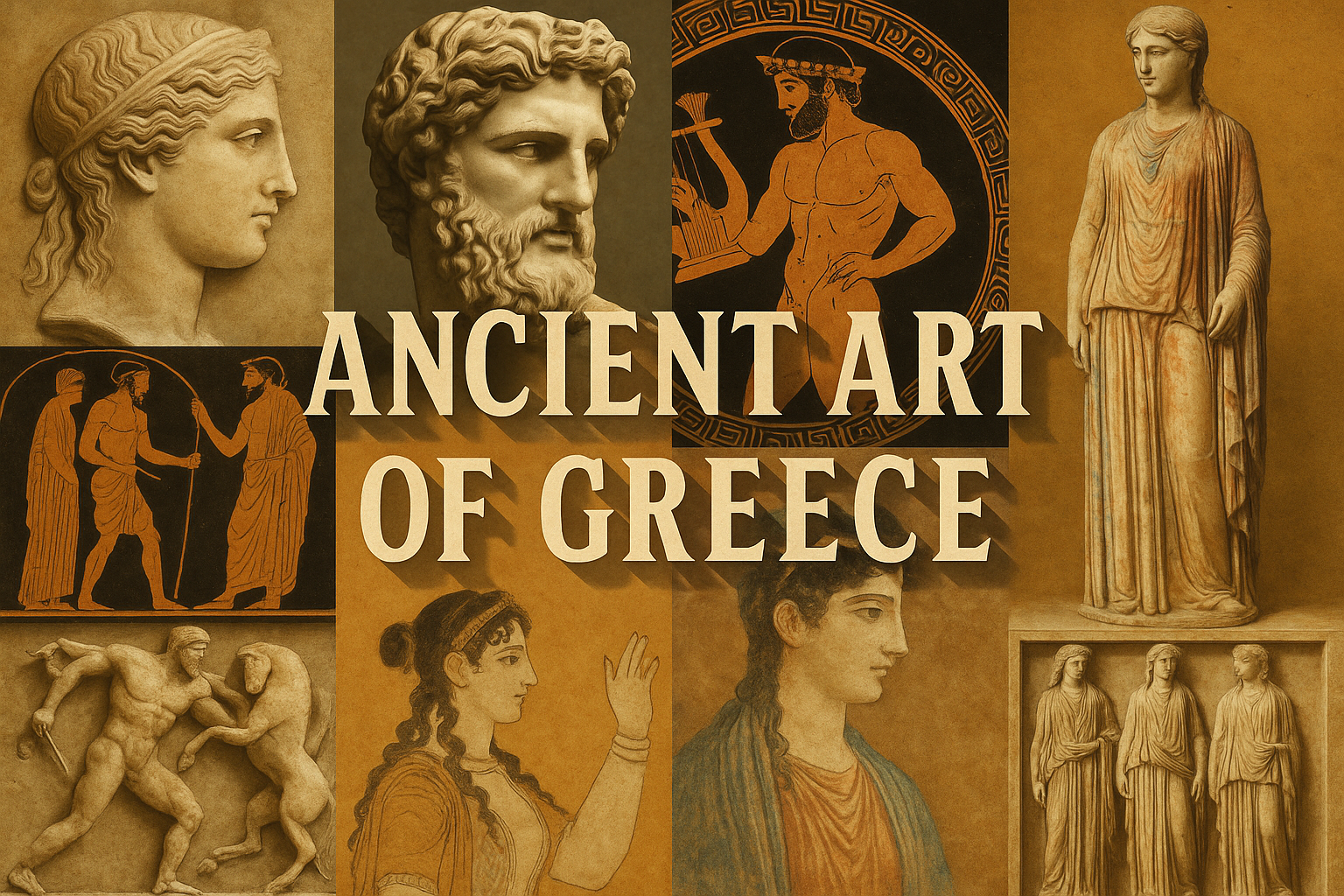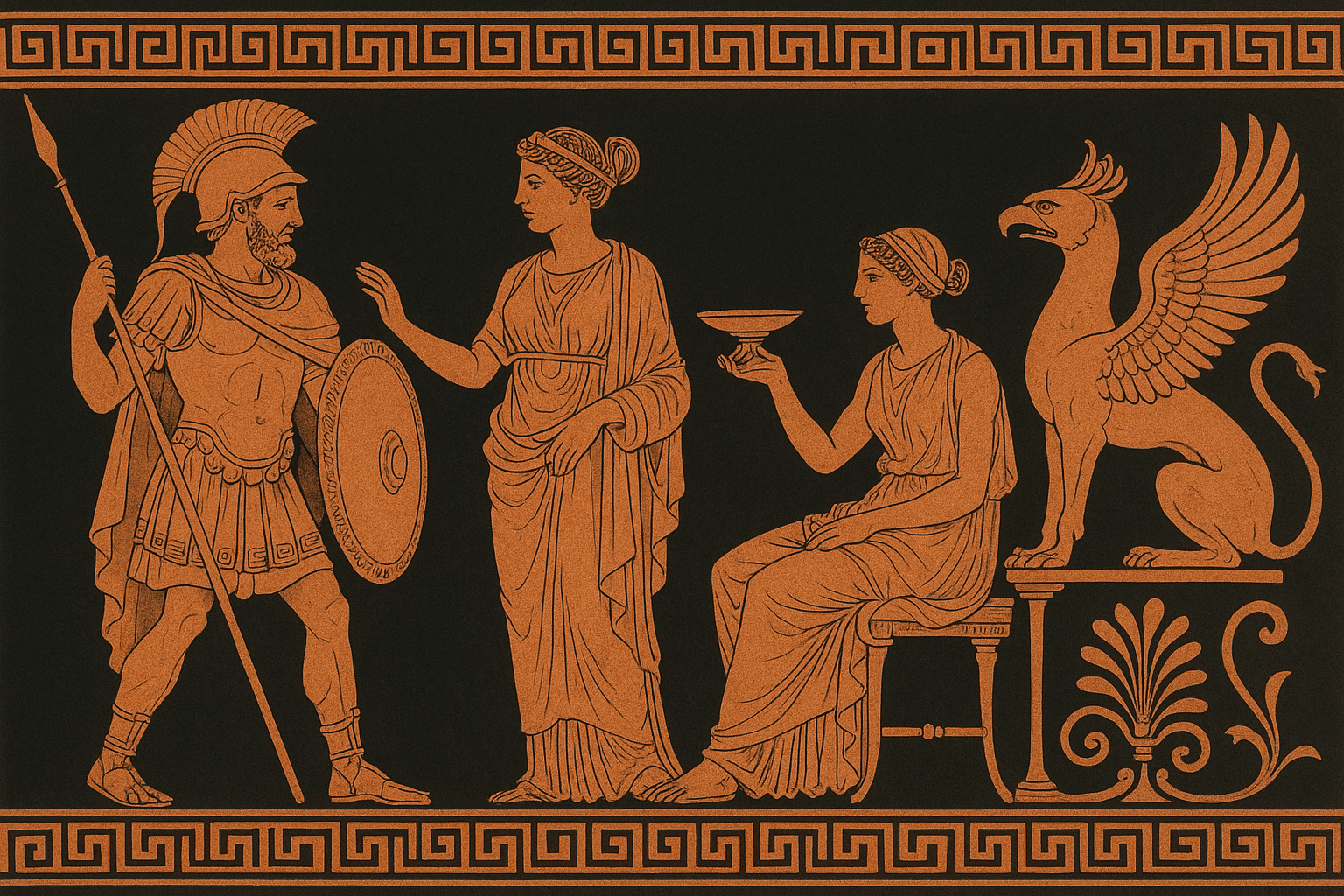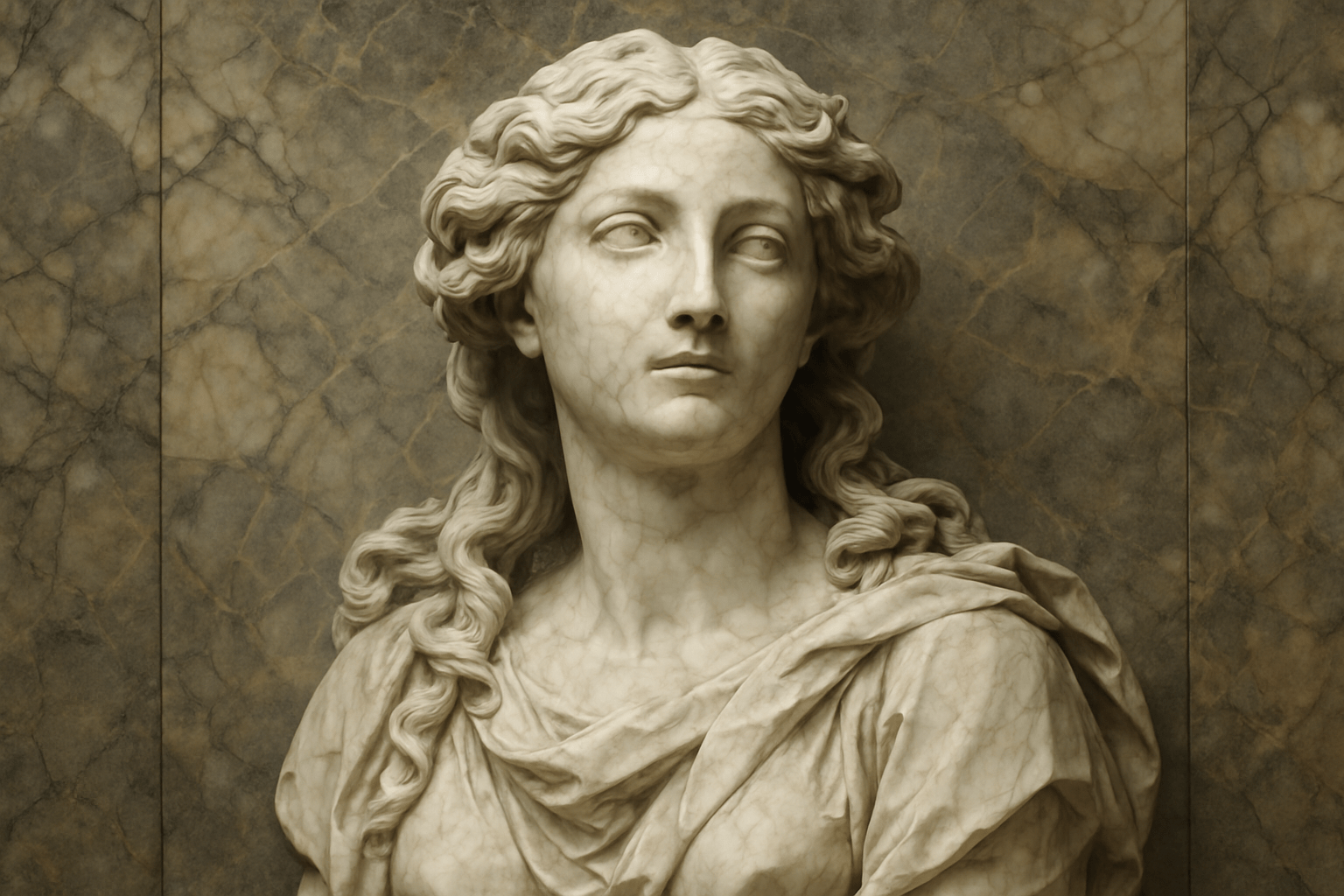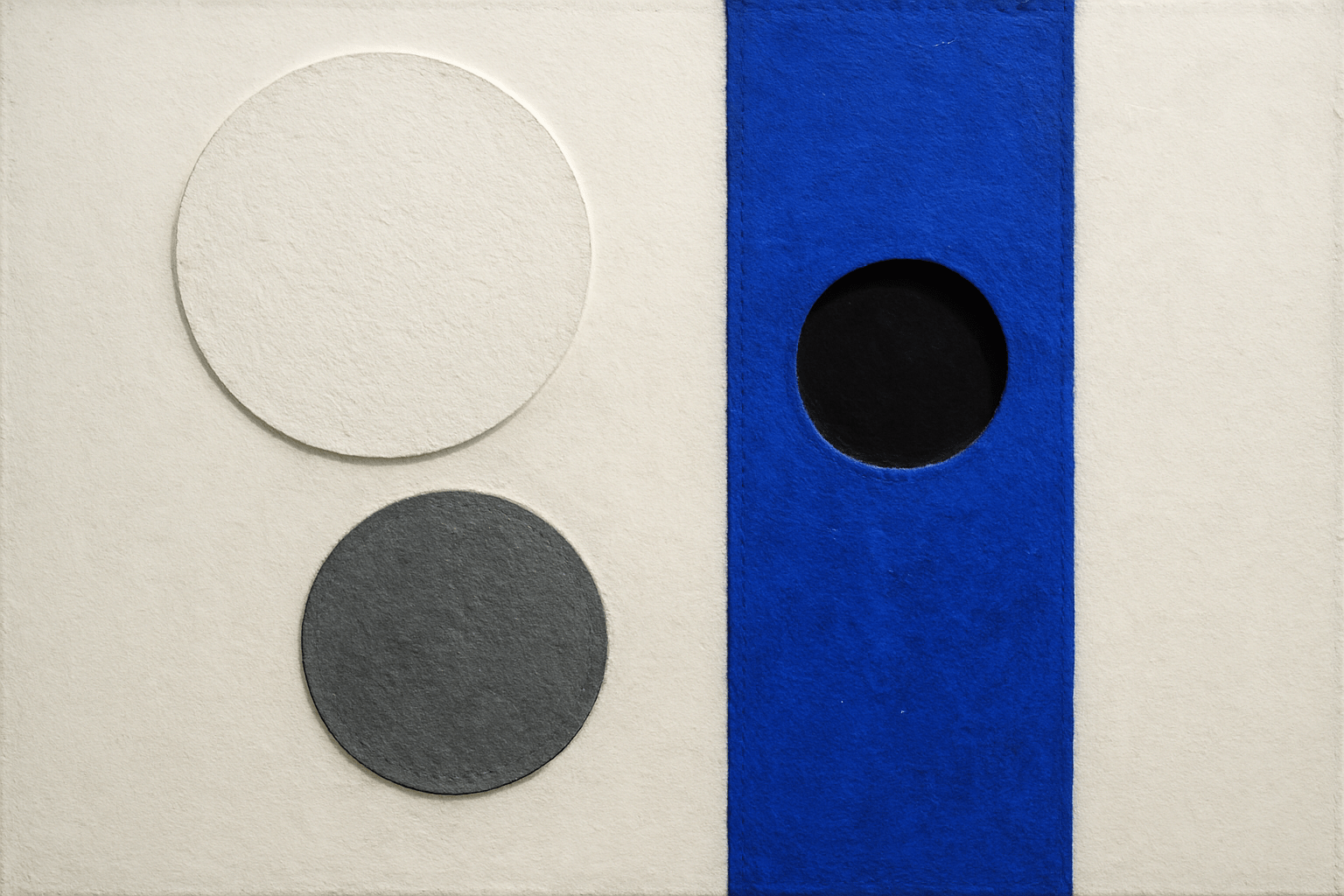
Ancient Art of Greece
The art style of Ancient Greece is characterized by its use of geometric shapes and patterns, as well as its focus on the human form. Additionally, Ancient Greek art often features scenes from mythology or daily life.
AOI thinking about Ancient Art of Greece [+_~]-/
Overview and Quickfacts
The art style of Ancient Greece is characterized by its use of simple yet elegant lines and shapes. Ancient Greek artists often used geometric forms to create their art, which resulted in a clean and orderly appearance. This art style is often associated with the Classical period of Greek history, which lasted from the 5th to the 4th centuries BC.
Can understand it also, as:
Classical Art, Greek Art
Categorize it as:
Impressionism, Modernism
.: Dreaming :.
holds a HAIKU for the art style
:. Thought is power .:
Detailed Description
The ancient art of Greece is characterized by its unique style and aesthetic, which has been influential for centuries. Greek art is known for its realism and idealism, as well as its use of perspective and proportion. Greek artists were also masters of storytelling, often using their art to depict myths and legends. Some of the most famous Greek artists include the painters Apelles and Polygnotus, the sculptors Pheidias and Praxiteles, and the architect Ictinus. Greek art has been treasured by many cultures throughout history, and has even inspired modern artists such as Pablo Picasso. If youÃÂÃÂre interested in learning more about the ancient art of Greece, be sure to check out the resources below. YouÃÂÃÂll find information on famous Greek artists, as well as some of the most iconic works of Greek art.
.. beep, beep, beep ..
<START OF TRANSMISSION>
1. The art of ancient Greece is usually divided into four periods: the Geometric, Archaic, Classical, and Hellenistic. 2. The Geometric period is characterized by simple, abstract designs, often featuring geometric shapes such as triangles, circles, and squares. 3. The Archaic period saw the rise of representational art, with artists beginning to depict humans and other figures in their work. 4. The Classical period is considered the Golden Age of Greek art, marked by the highly realistic and naturalistic style of the great sculptors such as Phidias and Praxiteles. 5. The Hellenistic period is characterized by a more emotionally expressive style, as seen in the art of Alexander the Great's court painter Apelles. 6. Ancient Greek art was primarily concerned with the depiction of the human form, both in sculpture and painting. 7. The human figure was often idealized in Greek art, with men depicted as strong and muscular, and women as beautiful and graceful. 8. Greek artists made use of a variety of different materials, including stone, marble, bronze, and clay. 9. Ancient Greek sculpture is perhaps best known for its life-size and larger-than-life statues of gods and heroes. 10. The most famous example of Greek painting is the frescoes of the Minoan civilization, which were discovered on the island of Crete. 11. Greek architecture is characterized by its use of columns, which were often decorated with carved reliefs. 12. The Parthenon, a temple dedicated to the goddess Athena, is perhaps the most famous example of Greek architecture. 13. Greek pottery is characterized by its brightly painted scenes, often featuring mythological or historical subjects. 14. The Greeks were also responsible for the development of coinage, and their coins often featured artistic designs. 15. Ancient Greek art was greatly influenced by the art of the neighboring cultures of Egypt and Persia. 16. Greek art also had a significant impact on the development of Roman art. 17. Many of the greatest works of Greek art were lost or destroyed over the centuries. 18. The study of Greek art has been greatly aided by the discovery of a number of important archaeological sites. 19. Many of the most important works of Greek art are now housed in museums around the world. 20. The study of Greek art continues to be an important part of the curriculum of many art schools.
<EOF>
.. robbel bob
Visual Examples from our image gallery
Coming soon, we are so slow .. might never come
Artists, Paintings, and more
(be aware, can be highly speculative)
Artists (be aware, speculation possible):
1. Agasias of Ephesus (-530 BC) 2. Andokides of Athens (ca. 520- ca. 450 BC) 3. Antiphanes of Athens (ca. 410-ca. 340 BC) 4. Aristophanes of Athens (ca. 446-ca. 386 BC) 5. Euphronius of Athens (fl. ca. 520 BC) 6. Exekias of Athens (ca. 525-ca. 455 BC) 7. Hermonax of Athens (fl. ca. 520 BC) 8. Kleitias of Athens (fl. ca. 570 BC) 9. Lydus of Sicyon (fl. ca. 500 BC) 10. Myron of Athens (ca. 480-ca. 440 BC) 11. Nikosthenes of Athens (fl. ca. 520 BC) 12. Onatas of Agrigentum (fl. ca. 470 BC) 13. Polygnotus of Thasos (fl. ca. 470-440 BC) 14. Pythagoras of Rhegium (fl. ca. 500 BC) 15. Scopas of Paros (ca. 395-ca. 335 BC) 16. Sosiphanes of Athens (fl. ca. 520 BC) 17. Telecles of Athens (fl. ca. 520 BC) 18. Theodorus of Samos (fl. ca. 530 BC) 19. Xenocles of Athens (fl. ca. 520 BC) 20. Zeuxis of Heraclea (ca. 464-ca. 394 BC) 21. Aetion of Athens (fl. ca. 400 BC) 22. Cephisodotus the Elder of Athens (fl. ca. 400 BC) 23. Euphranor of Corinth (fl. ca. 350 BC) 24. Leochares of Athens (fl. ca. 350 BC) 25. Lysippus of Sicyon (ca. 395-ca. 305 BC) 26. Praxiteles of Athens (ca. 400-330 BC) 27. Scopas of Athens (fl. ca. 350 BC) 28. Timarchus of Corinth (fl. ca. 350 BC) 29. Xenocrates of Athens (ca. 396-ca. 314 BC) 30. Zeuxis of Athens (fl. ca. 350 BC)
Artworks (be aware, speculation possible)
1. The Birth of Venus, by Sandro Botticelli (1485) 2. The Parthenon, by Phidias (438 BC) 3. The Temple of Zeus at Olympia, by Phidias (432 BC) 4. The Statue of Zeus at Olympia, by Phidias (432 BC) 5. The Elgin Marbles, by Phidias (438-432 BC) 6. The Sistine Chapel, by Michelangelo (1512) 7. The Last Supper, by Leonardo da Vinci (1498) 8. The Mona Lisa, by Leonardo da Vinci (1503-1506) 9. The Vitruvian Man, by Leonardo da Vinci (1490) 10. The School of Athens, by Raphael (1510) 11. The Battle of Alexander at Issus, by Albrecht DÃÂürer (1529) 12. The Nude Maja, by Francisco Goya (1797-1800) 13. The Third of May 1808, by Francisco Goya (1814) 14. The Persistence of Memory, by Salvador DalÃÂà(1931) 15. The Treachery of Images, by RenÃÂé Magritte (1928-1929) 16. The Son of Man, by RenÃÂé Magritte (1964) 17. The Great Wave off Kanagawa, by Katsushika Hokusai (1829-1833) 18. The Starry Night, by Vincent van Gogh (1889) 19. The Scream, by Edvard Munch (1893) 20. Guernica, by Pablo Picasso (1937) 21. Les Demoiselles d’Avignon, by Pablo Picasso (1907) 22. The Night CafÃÂé, by Vincent van Gogh (1888) 23. The Persistence of Memory, by Salvador DalÃÂà(1931) 24. The Treachery of Images, by RenÃÂé Magritte (1928-1929) 25. The Son of Man, by RenÃÂé Magritte (1964) 26. The Great Wave off Kanagawa, by Katsushika Hokusai (1829-1833) 27. The Starry Night, by Vincent van Gogh (1889) 28. The Scream, by Edvard Munch (1893) 29. Guernica, by Pablo Picasso (1937) 30. Les Demoiselles d’Avignon, by Pablo Picasso (1907)
Epoch
The art style of Ancient Greece is generally considered to span from the early Bronze Age period until the death of Alexander the Great in 323 BC.
AI ART RESSOURCES (AKA, well Tools)
Helping tools -> predefined search links on other pages:

















